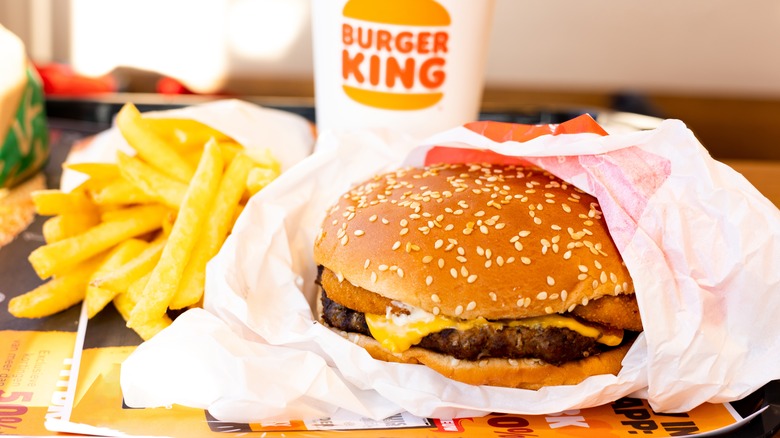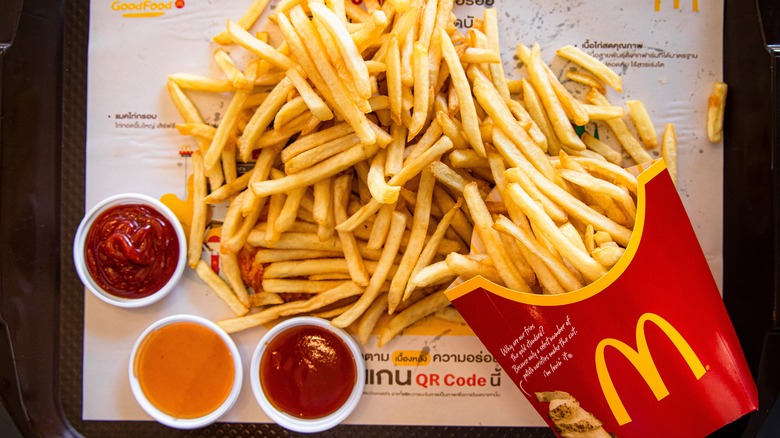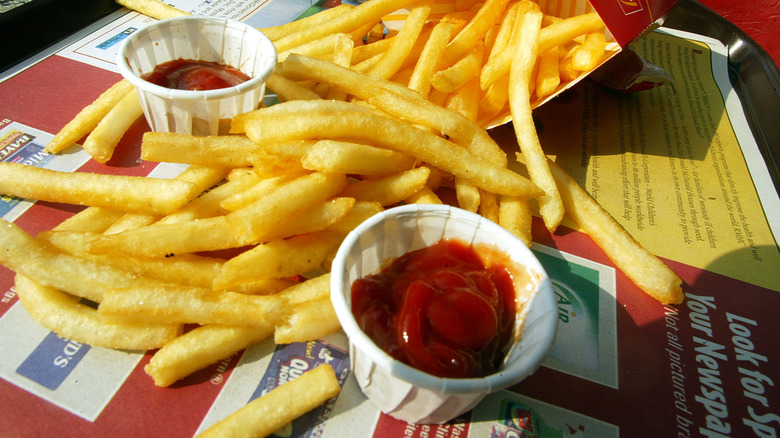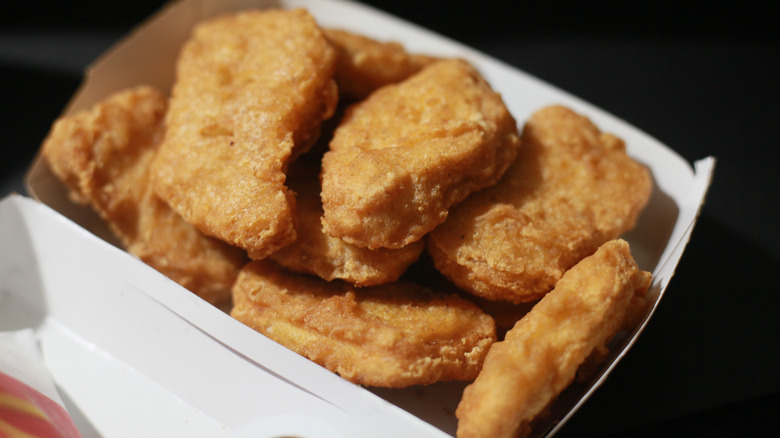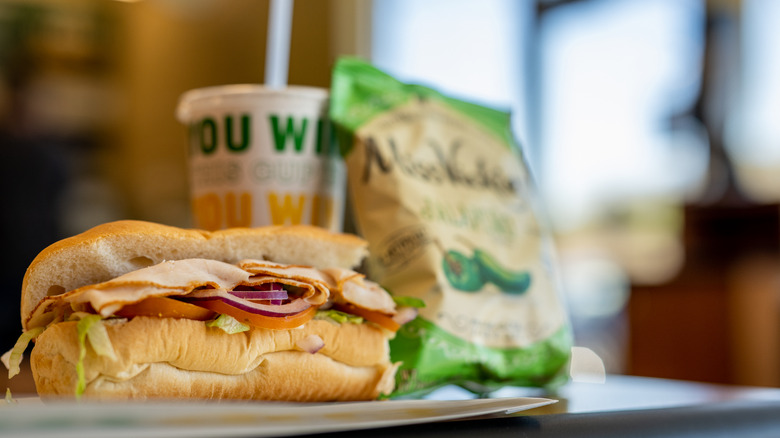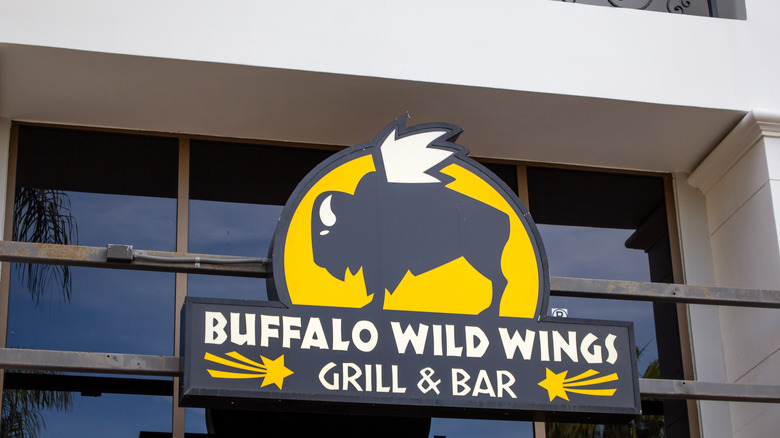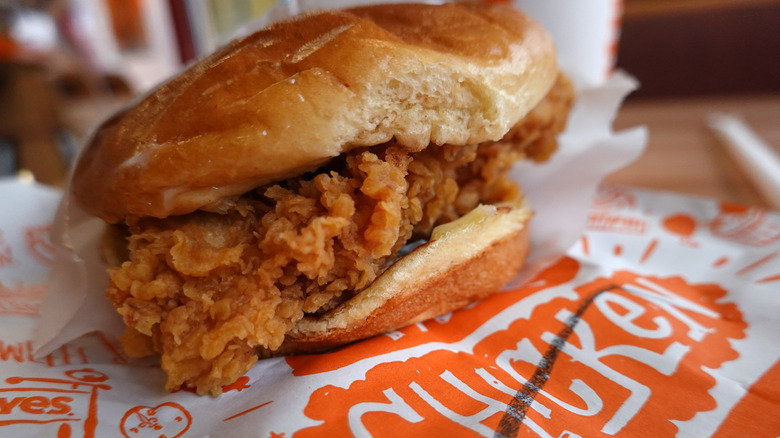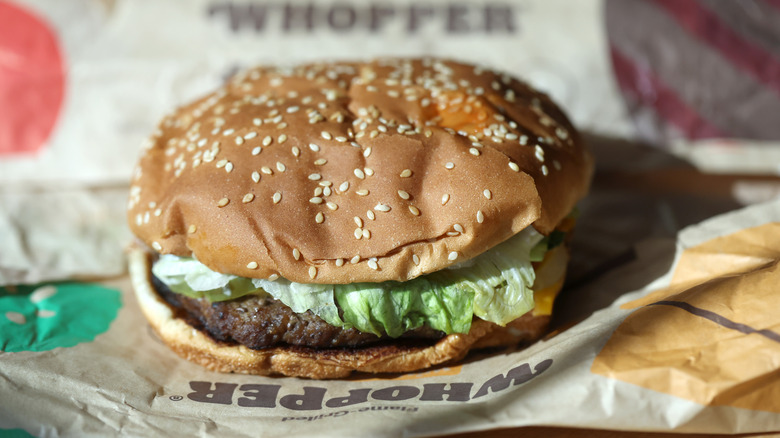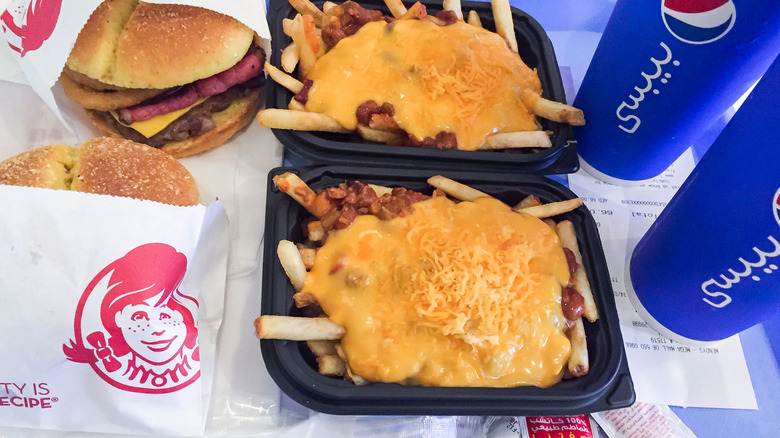The Ingredients That Give These Fast Food Items Their Distinct Flavors
Ask anyone who eats fast food on a regular basis, and they will have their preferences. It is more than likely they will feel pretty strongly about them as well. From regional favorites like In-N-Out to nationwide chains like McDonald's, every fast food joint has items with distinct flavors and styles. Most places have at least one special (and sometimes secret) ingredient in the preparation of one or more of their items that gives the food a special flair. This is the stuff people keep coming back for, whether or not they know it.
But have you ever wondered what it is that gives a Chicken McNugget that distinct flavor you've come to know over the years? Have you ever wondered how Wendy's chili has endured all this time as a staple of the menu? Well, it all comes down to the ingredients that these fast food chains use to make their specialty items stand out. Often times, it is just one extra ingredient that will make all the difference.
From McDonald's to Wendy's and many major fast food chains in between, these are the ingredients that give the signature dishes at these restaurants their distinct flavor.
McDonald's fries
Do you love the fries at McDonald's? If you do and believe they're the best fast food fries, there's a not-so-secret reason for that magic. If you thought that McDonald's fries were vegetarian, you might want to think again. The storied fast food franchise enhances its french fries with what it refers to as "natural beef flavor."
This natural beef flavor is added instead of frying the potatoes with beef tallow, which is what the chain used in the past. The rendered beef fat gave the fries more flavor, but McDonald's was eventually called out for using it. So, in 1990, all McDonald's locations switched to using vegetable oil to fry the french fries. The natural beef flavor is added to the fries to artificially give them that extra taste bump in place of the beef tallow. To this day, the fries served at McDonald's are not, and have never been, vegetarian or vegan friendly.
McDonald's ketchup
One unsung hero of McDonald's ingredients is the ketchup. Apart from being one of the ingredients that gives the cheeseburgers their distinctive flavor, the ketchup at McD's reigns supreme as a dipping sauce. Nothing goes better with McDonald's french fries than McDonald's ketchup, and there's a reason for that. The worldwide fast food chain isn't just using Heinz. No, McDonald's has a recipe all its own that utilizes one extra ingredient that sets it apart in a couple of ways.
Compared to Heinz (the leading ketchup brand in the U.S.) specifically, McDonald's recipe makes one major deviation: It adds water. According to the company, the ketchup is made using tomato concentrate, vinegar, both high-fructose and regular corn syrup, water, salt, and "natural flavors." This is nearly identical to what is found in Heinz ketchup, minus the water. The addition of water gives McDonald's ketchup a thinner and sweeter flavor that has become a trademark of the chain. Additionally, there are added ingredients in the Heinz mixture like powered onion that are absent in what McDonald's serves at its establishments.
McDonald's Chicken McNuggets
Love them or hate 'em, you have to admit McDonald's Chicken McNuggets have a specificity to their flavor. There is something that gives them that unique taste that sets them apart from nuggets from Wendy's and other competitors. That extra flavor is celery, specifically celery salt.
Celery salt is a mixture of ground up celery seed and regular salt. Most commonly, you can find celery salt atop the iconic Chicago hot dog.
This same flavor is said to enhance the taste in McDonald's McNuggets. Alongside white pepper, celery salt is included in the breading and makes the McNuggets distinct in a way that is unidentifiable to most customers. In 2014, McDonald's released a video detailing how Chicken McNuggets are made. In the video, a quality assurance employee details what she is tasked to look and taste for when testing nuggets, including "light pepper and celery notes" (via the LA Times).
Subway bread
This one sparked a controversy that you may remember hearing about: What exactly is it — cake or bread? In 2020, a court in Ireland ruled that the bread at the international sandwich chain was not bread but, in fact, was cake. The court ruled that the sugar content in Subway's bread was too high for it to be considered bread, according to the parameters established the Irish Value-Added Tax Act of 1972.
This goes to show that if you've ever noticed a distinct quality to both the flavor and texture of the bread at Subway, you might have actually been onto something. Sugar is crucial to baking, but adding more sugar to a bread recipe will change its properties. Obviously, it will be sweeter; sugar also retains water, so you will get a more glutenous and tender bread. So, now the soft and sweet nature of the bread at Subway should make a lot more sense.
Buffalo Wild Wings fries
While McDonald's may have ditched using beef tallow for its fries, one chain that isn't even known for burgers is still keeping up the tradition. That's right — the chicken wing experts at Buffalo Wild Wings cook french fries in beef shortening, and that's not all it's used for at the fast food chain. In fact, all of the chain's fried food options are fried in beef shortening. This means that even options like the fried Cauliflower Wings and Cheese Curds at Buffalo Wild Wings are not vegetarian.
While this might give the wings and fries a certain flavor that has many people coming back for more week after week, this means that nothing fried at the chain can be eaten by vegetarians or vegans. While frying with beef is increasingly a rarity among restaurant chains, Buffalo Wild Wings doesn't appear to plan on making any changes to this practice in the near future.
Popeye's chicken
This secret ingredient may be a bit controversial, but it is also more common that you might think in the world of fast food and quick service. Popeye's is hardly unique in using MSG in its famous fried chicken recipe, but that revelation has nonetheless been considered newsworthy in recent years. The chain couldn't help but make headlines for its inclusion of an ingredient that has seen consumer backlash.
MSG, aka monosodium glutamate, is a naturally occurring chemical that is used to enhance the umami flavor of whatever it is added to. There has been concern that adding MSG to a dish can cause health problems, but many of those concerns are unwarranted (via Healthline). While the FDA has recognized MSG to be safe, Popeye's has still come under fire for the decision and has reconsidered the inclusion of this ingredient.
However, the chain stated in 2022 that supply chain shortages were making it difficult to make sweeping changes to products such as a recipe change. So, as it stands, Popeye's still uses MSG in its chicken, though that may not be the case forever.
Burger King Whopper
The most famous Burger King sandwich is the legendary Whopper. The landmark sandwich itself is fairly standard ingredient-wise, but there is one element of the Whopper, and indeed of all the burgers at BK, that sets it apart. At Burger King, it's the beef that makes the difference — not in the quality or quantity of the product but in how it is prepared. Burger King's flame-broiling method sets it apart in the competitive landscape of fast food burgers. At least, the company hopes so.
If you have ever eaten a Whopper or burger from BK, you will be familiar with that distinct, flame-broiled taste. When it comes down to it, this isn't because of a gimmick or additive like liquid smoke. The real secret ingredient at Burger King really is just fire. Simple as that.
In fact, in 2021, the chain launched an ad in the U.K. informing viewers that it uses real fire. This debunks myths of the franchise using liquid smoke or other flavor enhancers to create its burgers' signature taste.
Wendy's Chocolate Frosty
The Wendy's Frosty has carved out a refreshing niche of its own in the world of fast food. Not hard enough to be soft serve but not quite a milkshake, this frozen dessert is a perfect palette cleanser that also acts as a wonderful dip for fries. Seriously, salty-sweet parings have been scientifically determined to be delicious. But the fan-favorite Chocolate Frosty also has a hidden edge flavor-wise that gives it an advantage over competing fast food chocolate ice creams, and it's one that might seem counterintuitive.
That unexpected ingredient that makes the Chocolate Frosty at Wendy's so delicious is actually vanilla. The distinct taste you are used to in the item comes the unique blend of vanilla and chocolate flavor. This method has been in place since the very beginning of the Frosty. The treat's distinct flavor was as important to Wendy's founder Dave Thomas as the shape and flavor of the chain's trademark burgers.
Wendy's Chili
Some people love Wendy's for the burgers; others do for the spicy chicken that comes in sandwich and nugget form. But quite a few mega-fans have been showing up for decades for one thing — the chili. Wendy's famous chili hasn't been without its share of infamy, but, over the years, it has held up as one of the staples that is never leaving the menu. As it turns out, Wendy's chili is special for an extra ingredient that most fast food places don't include in their chili. And yes, it really does make a huge difference.
Wendy's adds sugar to its chili to give it the characteristic flavor that regular diners are used to. Alongside red and pink kidney beans, onion, celery, green peppers, tomato, and ground beef, sugar is listed as one of the ingredients in the chili con carne.
This actually makes sense, given the usefulness of sugar. When added to savory dishes with meats and vegetables, sugar can bring out a natural sweetness in the ingredients that adds even more flavor. In particular, it can add caramelization to beef, bringing out a deeper, meatier taste.
Static Media owns and operates Daily Meal and Mashed.
